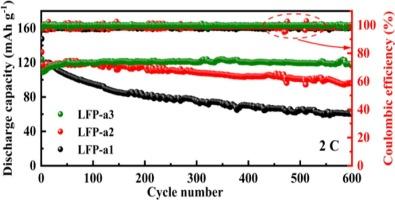非晶FePO4前驱体合成LiFePO4正极材料:Li/P摩尔比对晶体缺陷形成和电化学性能的影响
IF 3.3
4区 材料科学
Q3 CHEMISTRY, PHYSICAL
引用次数: 0
摘要
磷酸铁锂(LiFePO4)作为一种优良的正极材料,已广泛应用于商用锂离子电池(LIBs)中。然而,合成条件对非晶态磷酸铁(FePO4)制备的LiFePO4阴极的影响尚不清楚。本文以FePO4为前驱体,研究了Li/P摩尔比对LiFePO4结晶度和电化学性能的影响。当LiFePO4中Li/P摩尔比约为1时,材料表现出优异的长期循环稳定性,500次循环后容量保持率高达97%。此外,多重表征表明,较高的Li/P摩尔比会导致LiFePO4晶体中缺陷浓度的增加,这不仅降低了LiFePO4的可逆容量,而且影响了LiFePO4的结构稳定性,导致其循环稳定性差,容量退化快。因此,该工作为合理设计和合成非晶FePO4前驱体的高性能LiFePO4阴极提供了科学的见解。本文章由计算机程序翻译,如有差异,请以英文原文为准。

Synthesis of LiFePO4 cathode materials from amorphous FePO4 precursor: Effects of Li/P molar ratio on crystal defect formation and electrochemical performance
As an excellent cathode material, lithium iron phosphate (LiFePO4) has been widely used in commercial lithium-ion batteries (LIBs). However, the impact of synthetic conditions on LiFePO4 cathode derived from amorphous iron phosphate (FePO4) remains underexplored. In the present study, the effects of Li/P molar ratio on the crystallinity and electrochemical properties of LiFePO4 were investigated in detail using FePO4 as a precursor. When the Li/P molar ratio in LiFePO4 was approximately 1, the material exhibited an excellent long-term cycling stability with a high capacity retention of 97 % after 500 cycles. In addition, multiple characterizations demonstrate that the higher molar ratio of the Li/P resulted in the higher concentration of defects in LiFePO4 crystals, which not only reduced the reversible capacity but also compromised the structural stability, leading to a poor cyclic stability and quick capacity degradation. Therefore, such a work could provide a scientific insight for rational design and synthesis of high-performance LiFePO4 cathodes from amorphous FePO4 precursor.
求助全文
通过发布文献求助,成功后即可免费获取论文全文。
去求助
来源期刊

Solid State Ionics
物理-物理:凝聚态物理
CiteScore
6.10
自引率
3.10%
发文量
152
审稿时长
58 days
期刊介绍:
This interdisciplinary journal is devoted to the physics, chemistry and materials science of diffusion, mass transport, and reactivity of solids. The major part of each issue is devoted to articles on:
(i) physics and chemistry of defects in solids;
(ii) reactions in and on solids, e.g. intercalation, corrosion, oxidation, sintering;
(iii) ion transport measurements, mechanisms and theory;
(iv) solid state electrochemistry;
(v) ionically-electronically mixed conducting solids.
Related technological applications are also included, provided their characteristics are interpreted in terms of the basic solid state properties.
Review papers and relevant symposium proceedings are welcome.
 求助内容:
求助内容: 应助结果提醒方式:
应助结果提醒方式:


